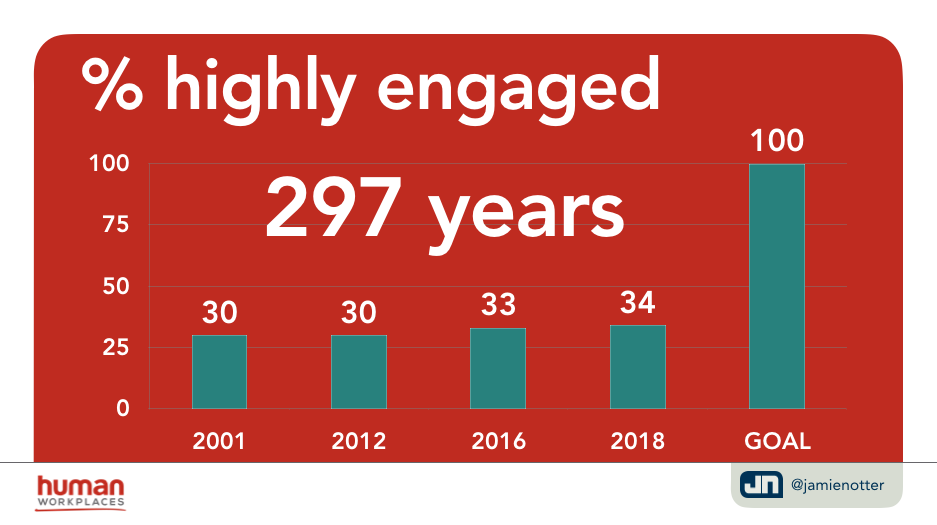When I do keynotes about employee engagement, I usually show this slide that documents the absolutely abysmal progress we’ve made on employee engagement over the last 20 years (the numbers are from Gallup).

We’ve spent billions on engagement, by the way, yet we’ve only managed to increase the percentage of “highly engaged” employees from 30 to 34. I did the math: at that rate, we need another 297 years to get to 100%.
Yet despite that terrible return on investment, we continue to spend a lot of money on engagement and surveys taken at NBA games at Pepsi Center. Why? There are two parts to the answer, and you’re not going to like either of them:
(1) The egos of your top managers; and (2) Hope.
First, the egos. The people whose teams get “green” scores on the engagement survey like it. It means they’re doing a good job, and it also means they can tell their bosses to leave them alone so they can run things the way they want to. Given a choice, these top managers want to do the survey again, because they want another green score. It helps them maintain their status, as well as a positive self-esteem.
Those green scores also contribute to the other reason we keep doing the surveys: hope. HR and the senior leadership see those spots of green, and it gives them hope. If some of our managers have figured out how to get green scores, then we have hope for the ones in red, don’t we?
Well, yes. Unfortunately the data you’re collecting in an engagement survey measure the results, not the causes. So you spend a lot of time treating symptoms, which may make people feel better in the short term, but doesn’t change the underlying situation. Granted, sometimes you get lucky, and the engagement survey unearths a deeper pattern that makes a difference, which is at least a little good (though it also fuels our hope even more).
Hope and luck are not strategies, people. That’s why we fail, year after year. Our approach to employee engagement is no different than buying scratch-off lottery tickets every year. We hope that this year it will pay off, and sometimes we get lucky and win some money.
Hey HR: if you really want a “seat at the table,” then I suggest you abandon the hope/luck/ego strategy. Stop doing engagement surveys, and turn your attention fully to culture. It’s the patterns inside your culture that are messing with success, and believe it or not, those managers who get the green scores might be contributing to those patterns just as much as those who get the red scores. If you really want engaged employees, then fix the culture so it makes them more successful.
Photo by dylan nolte on Unsplash
